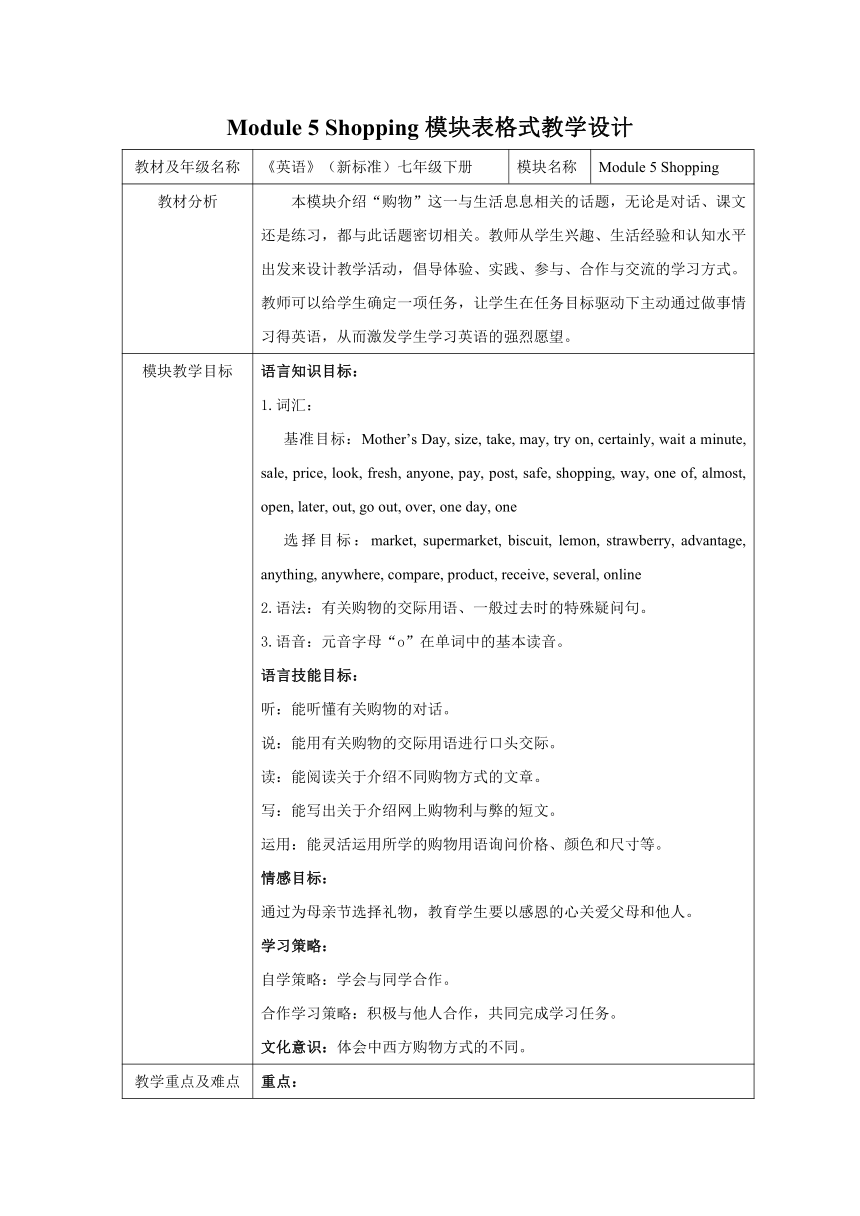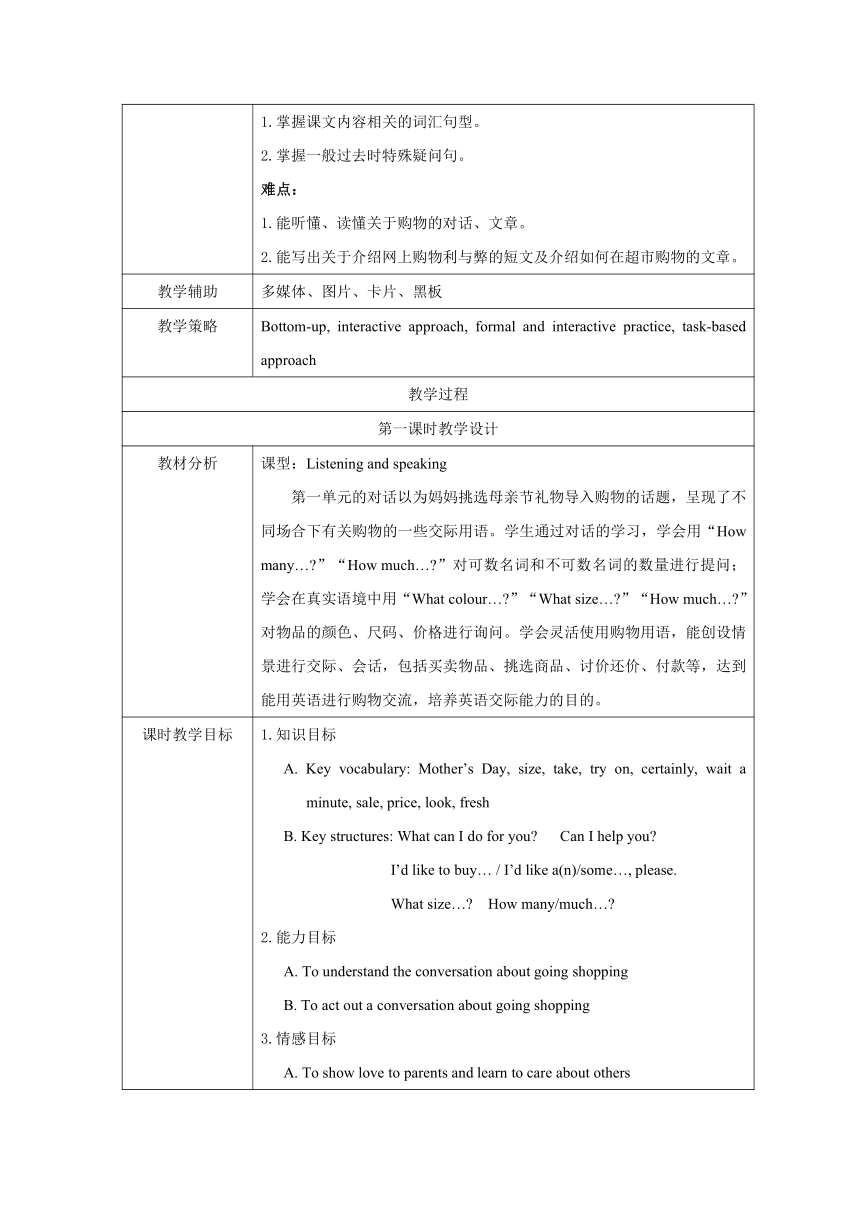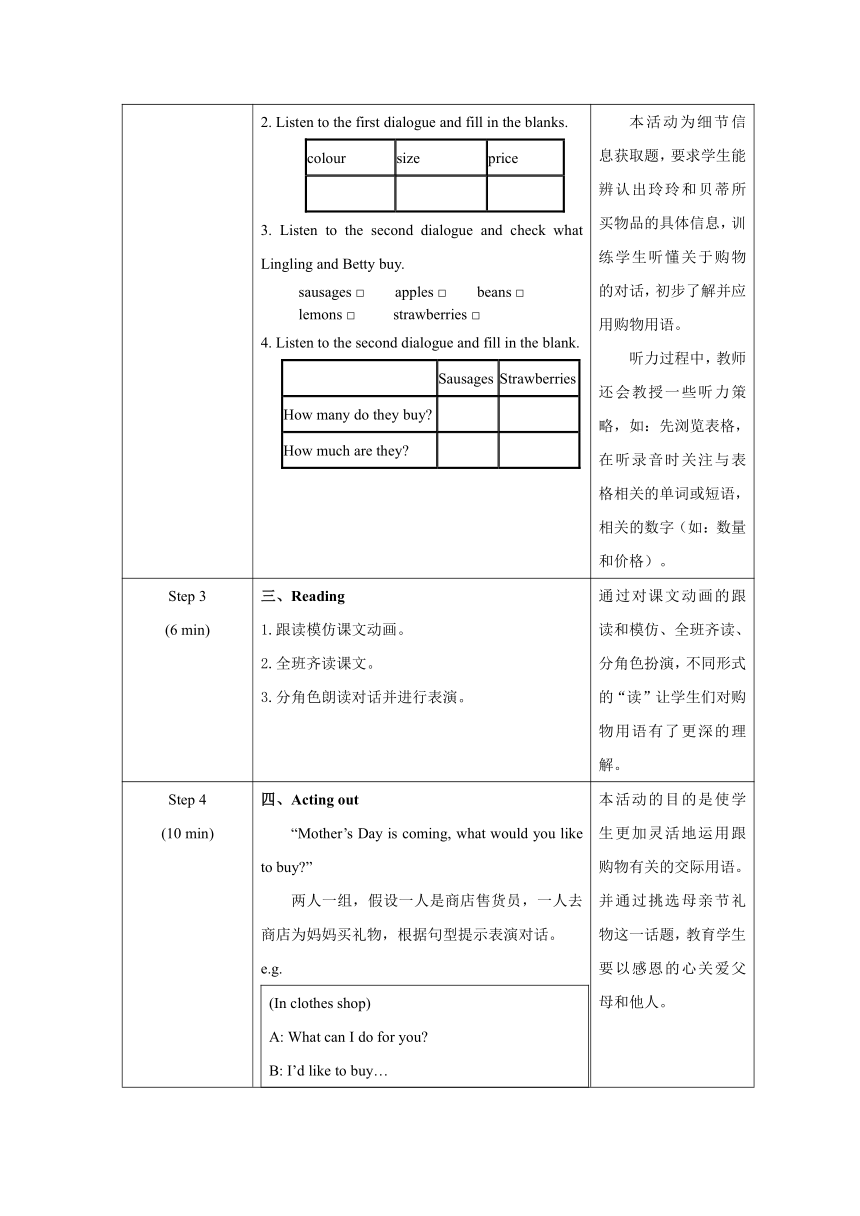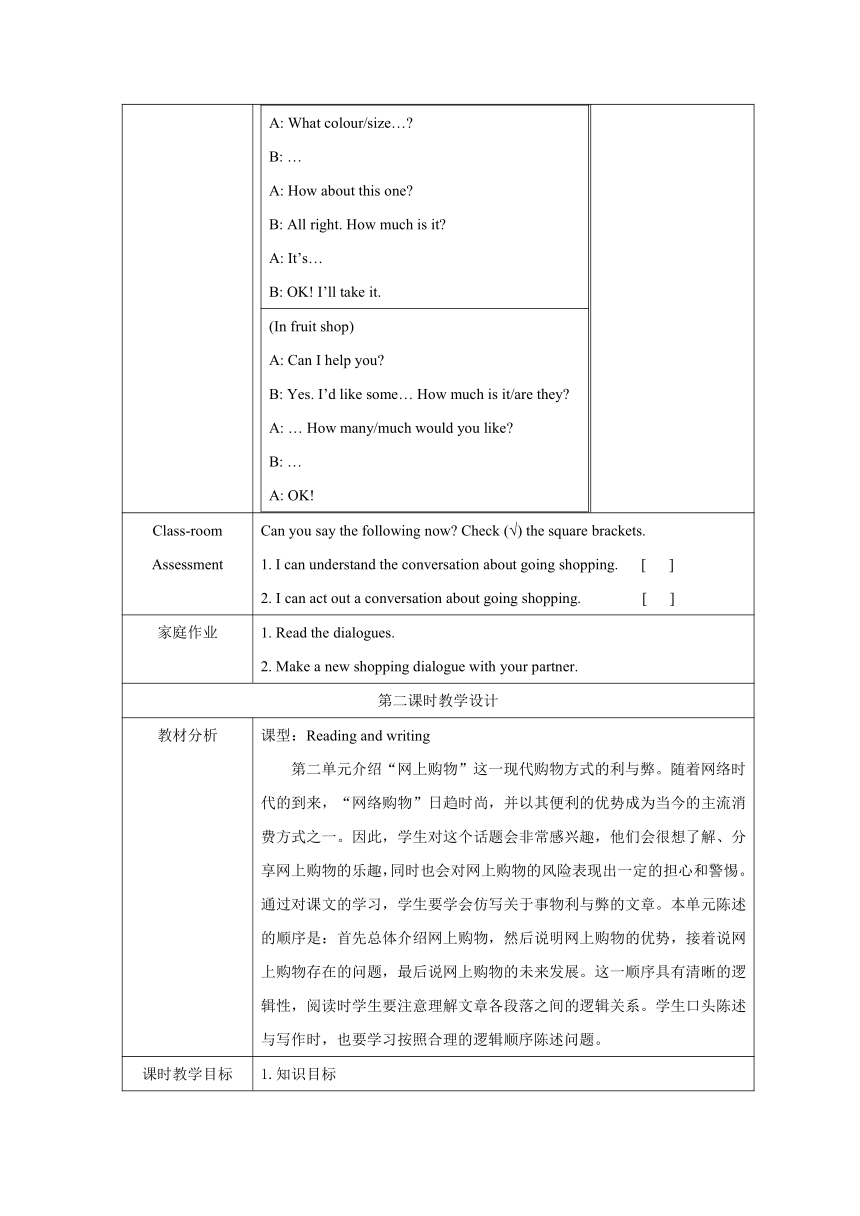外研版七年级下册 Module 5 Shopping 模块表格式教学设计
文档属性
| 名称 | 外研版七年级下册 Module 5 Shopping 模块表格式教学设计 |  | |
| 格式 | doc | ||
| 文件大小 | 103.0KB | ||
| 资源类型 | 教案 | ||
| 版本资源 | 外研版 | ||
| 科目 | 英语 | ||
| 更新时间 | 2023-01-03 13:25:02 | ||
图片预览





文档简介
Module 5 Shopping模块表格式教学设计
教材及年级名称 《英语》(新标准)七年级下册 模块名称 Module 5 Shopping
教材分析 本模块介绍“购物”这一与生活息息相关的话题,无论是对话、课文还是练习,都与此话题密切相关。教师从学生兴趣、生活经验和认知水平出发来设计教学活动,倡导体验、实践、参与、合作与交流的学习方式。教师可以给学生确定一项任务,让学生在任务目标驱动下主动通过做事情习得英语,从而激发学生学习英语的强烈愿望。
模块教学目标 语言知识目标:1.词汇:基准目标:Mother’s Day, size, take, may, try on, certainly, wait a minute, sale, price, look, fresh, anyone, pay, post, safe, shopping, way, one of, almost, open, later, out, go out, over, one day, one 选择目标:market, supermarket, biscuit, lemon, strawberry, advantage, anything, anywhere, compare, product, receive, several, online2.语法:有关购物的交际用语、一般过去时的特殊疑问句。3.语音:元音字母“o”在单词中的基本读音。语言技能目标:听:能听懂有关购物的对话。说:能用有关购物的交际用语进行口头交际。读:能阅读关于介绍不同购物方式的文章。写:能写出关于介绍网上购物利与弊的短文。运用:能灵活运用所学的购物用语询问价格、颜色和尺寸等。情感目标:通过为母亲节选择礼物,教育学生要以感恩的心关爱父母和他人。学习策略:自学策略:学会与同学合作。合作学习策略:积极与他人合作,共同完成学习任务。文化意识:体会中西方购物方式的不同。
教学重点及难点 重点:1.掌握课文内容相关的词汇句型。2.掌握一般过去时特殊疑问句。难点:1.能听懂、读懂关于购物的对话、文章。2.能写出关于介绍网上购物利与弊的短文及介绍如何在超市购物的文章。
教学辅助 多媒体、图片、卡片、黑板
教学策略 Bottom-up, interactive approach, formal and interactive practice, task-based approach
教学过程
第一课时教学设计
教材分析 课型:Listening and speaking第一单元的对话以为妈妈挑选母亲节礼物导入购物的话题,呈现了不同场合下有关购物的一些交际用语。学生通过对话的学习,学会用“How many… ”“How much… ”对可数名词和不可数名词的数量进行提问;学会在真实语境中用“What colour… ”“What size… ”“How much… ”对物品的颜色、尺码、价格进行询问。学会灵活使用购物用语,能创设情景进行交际、会话,包括买卖物品、挑选商品、讨价还价、付款等,达到能用英语进行购物交流,培养英语交际能力的目的。
课时教学目标 1.知识目标A. Key vocabulary: Mother’s Day, size, take, try on, certainly, wait a minute, sale, price, look, freshB. Key structures: What can I do for you Can I help you I’d like to buy… / I’d like a(n)/some…, please. What size… How many/much… 2.能力目标 A. To understand the conversation about going shoppingB. To act out a conversation about going shopping3.情感目标 A. To show love to parents and learn to care about othersB. To cultivate the awareness of competition and cooperation
教学重点与难点 1.重点A. To master some useful words and expressions about the subjectB. To improve the abilities of listening2.难点To act out a conversation about going shopping
教学辅助 多媒体,黑板
教学方法 Bottom-up, interactive approach
教学内容 教学活动 设计意图
Step 1 (12 min) 一、Lead-in 1.向学生展示关于购物的图片及生词。2.两人合作,谈论“What would you like to buy for your mum on Mother’s Day ” 教师通过设置一个购物的情境,将单词教学融入其中,起导入话题和展示词汇的作用。并通过“word map”让学生们讨论在母亲节时,会为母亲准备什么礼物,为后面的听力活动做准备。
Step 2 (12 min) 二、Listening 1. Listen and answer the questions.1) What is Lingling going to buy for her mother on Mother’s Day 2) What is Betty going to make for her mother 3) What does Betty want to buy 4) When are they going to the shops a.听前让学生读题目。b.听录音并回答问题。如有需要,听第二遍,两人一组核对答案。c.教师请学生两人一组,一问一答,核对答案。2. Listen to the first dialogue and fill in the blanks.coloursizeprice3. Listen to the second dialogue and check what Lingling and Betty buy.sausages □ apples □ beans □ lemons □ strawberries □4. Listen to the second dialogue and fill in the blank.SausagesStrawberriesHow many do they buy How much are they 本活动是细节辨认活动,检查学生对听力语段中具体信息的掌握情况。本活动为细节信息获取题,要求学生能辨认出玲玲和贝蒂所买物品的具体信息,训练学生听懂关于购物的对话,初步了解并应用购物用语。听力过程中,教师还会教授一些听力策略,如:先浏览表格,在听录音时关注与表格相关的单词或短语,相关的数字(如:数量和价格)。
Step 3 (6 min) 三、Reading1.跟读模仿课文动画。2.全班齐读课文。3.分角色朗读对话并进行表演。 通过对课文动画的跟读和模仿、全班齐读、分角色扮演,不同形式的“读”让学生们对购物用语有了更深的理解。
Step 4 (10 min) 四、Acting out“Mother’s Day is coming, what would you like to buy ”两人一组,假设一人是商店售货员,一人去商店为妈妈买礼物,根据句型提示表演对话。e.g.(In clothes shop)A: What can I do for you B: I’d like to buy…A: What colour/size… B: …A: How about this one B: All right. How much is it A: It’s…B: OK! I’ll take it.(In fruit shop)A: Can I help you B: Yes. I’d like some… How much is it/are they A: … How many/much would you like B: …A: OK! 本活动的目的是使学生更加灵活地运用跟购物有关的交际用语。并通过挑选母亲节礼物这一话题,教育学生要以感恩的心关爱父母和他人。
Class-room Assessment Can you say the following now Check (√) the square brackets.1. I can understand the conversation about going shopping. [ ]2. I can act out a conversation about going shopping. [ ]
家庭作业 1. Read the dialogues.2. Make a new shopping dialogue with your partner.
第二课时教学设计
教材分析 课型:Reading and writing第二单元介绍“网上购物”这一现代购物方式的利与弊。随着网络时代的到来,“网络购物”日趋时尚,并以其便利的优势成为当今的主流消费方式之一。因此,学生对这个话题会非常感兴趣,他们会很想了解、分享网上购物的乐趣,同时也会对网上购物的风险表现出一定的担心和警惕。通过对课文的学习,学生要学会仿写关于事物利与弊的文章。本单元陈述的顺序是:首先总体介绍网上购物,然后说明网上购物的优势,接着说网上购物存在的问题,最后说网上购物的未来发展。这一顺序具有清晰的逻辑性,阅读时学生要注意理解文章各段落之间的逻辑关系。学生口头陈述与写作时,也要学习按照合理的逻辑顺序陈述问题。
课时教学目标 1.知识目标A. Key vocabulary: anyone, pay, post, safe, shopping, way, one of, almost, open, later, go out, over, one day, receive, advantage, productB. Key structures: … is changing our way of life You’ll be able to…2.能力目标 A. To understand the reading material about online shopping B. To learn to write a paragraph about online shopping3.情感目标A. To cultivate the interest of English learning through reading storiesB. To cultivate the awareness of competition and cooperation
教学重点与难点 重点:A. To master some useful words and expressions about the subject.B. To improve the ability of reading. 难点:To write a paragraph about online shopping.
教学辅助 多媒体、图片、卡片、黑板
教学方法 Bottom-up approach
教学内容 教学活动 设计意图
Step 1 (1 min) 一、Lead-in师生问好。
Step 2 (9 min) 二、Pre-reading1.学习新单词。通过图片展示生词,教师带读。2.关于网上购物的话题讨论。1) What can you buy 2) How do you pay for it 3) How is it changing our lives 4) Is it good or bad 本活动为后面的阅读活动从词汇和话题上做准备,起导入新课的作用,同时训练学生预测阅读内容的能力。
Step 3 (15 min) 三、While-reading1. Read the passage and check (√ ) the true sentences. 1) Online shopping is a new way of shopping. ( )2) You pay for online shopping before you receive it.( )3) Online shopping is very difficult. ( )4) It’s very safe to shop over the Internet. ( )5) Our way of life is changing because of online shopping. ( )a. 阅读前先审题。b. 读课文并勾出正确的句子。做完后两人一组核对答案。c. 教师请个别学生回答。2. Read the passage after the cartoon.3. Complete the passage.later out pay receiveInternet shopping is easy. You buy something online, you (1) ______ for it, then a few days (2) ______ you (3) ______ it by post. But going (4) ______ and shopping with friends is much more fun!a. 让学生读方框里的单词。b. 用单词的适当形式完成句子。c. 全班核对答案。d. 齐读文章。 本阅读活动的目的是训练学生获取细节信息的能力,教师可在平时的阅读训练中要求学生根据题目内容在文章中找出相关信息。本活动的目的是巩固和运用所学词汇。
Step 4 (15 min) 四、After-reading1. Work in pairs.a. 两人一组讨论并完成以下表格。 Shopping onlineAdvantagesDisadvantagesb. 请个别学生将其讨论结果在班上做分享。Keys:Advantages: quick, easy, can buy almost everything…Disadvantages: can’t see things first, not safe to pay over the Internet, less fun…2. Writinga. Ask the students to write sentences describing the advantages with first and second.First, you can shop at any time… Second, …b. Now write sentences describing the disadvantages.Introduce the first disadvantage with but.But many people like going out… 本活动要求学生讨论并列出网上购物的利与弊。本活动要求学生体会、运用所学的连词,将上述网上购物的观点写成句子。写作任务旨在训练学生根据所学语篇的结构进行仿写的能力,使学生初步掌握描述事物利与弊的写作方法。
Class-room Assessment Can you say the following now Check (√) the square brackets.1. I can understand the reading material about online shopping. [ ]2. I can write about the advantages and disadvantages of online shopping. [ ]3. I can write about the advantages and disadvantages of shopping at a supermarket. [ ]
家庭作业 写一篇关于在超市购物的文章。Begin like this: Supermarket shopping is not difficult. First, you choose the things on your shopping list…List the advantages.List the disadvantages.Finish like this: Shopping at a supermarket is fun.
第三课时教学设计
教材分析 课型:Revision and application 本模块重点教授关于购物的交际用语,教师有必要引导学生做适当的总结,并对学生有可能出现的问题加以强调。同时结合课本上的练习,创造丰富的课堂活动,帮助学生正确地使用这些交际用语。
课时教学目标 1.知识目标A. To summarize and consolidate expressions about going shoppingB. To revise new words and phrases2.能力目标To write a shopping list for a school picnic
教学重点与难点 重点:To summarize and consolidate the new vocabulary about going shopping难点:To write a shopping list for a school picnic
教学辅助 多媒体,黑板
教学方法 Formal and interactive practice, task-based approach
教学内容 教学活动 设计意图
Step 1 (5 min) 一、Warming-up 带学生复习Unit 1和Unit 2中的重点词汇与句型。 导入部分将复习前两个单元所学的词汇、句型,也为本单元语言操练奠定基础。
Step 2 (22 min) 二、Language practice1. Read through the example sentences in the box with the whole class. What colour does she like What size does she take How many/much would you like 2. Work in pairs教师展示图片,学生两人一组,对图片内容进行一问一答。e.g. what / size / take — What size do you take — Size S.1) what / size / take 2) how much / eggs 3) how much / beef 4) what / colour / like 3. Complete the sentences.1) Can I help you ____________________________. 2) How much are they _________________________.3) What size do you take _______________________.4) How much meat do you want _________________.5) Can I try it on ____________________________.6) How much is that T- shirt ____________________.7) What color would you like ___________________.8) What about this one ________________________.4. Grammar语法点拨——特殊疑问句:(1) 定义:以特殊疑问词开头,对句中某一成分提问的句子叫特殊疑问句。(2) 常用的特殊疑问词有:what(什么),who(谁),whose(谁的),which(哪个),when(何时),where(哪里),how(怎样),why(为何)等。(3) 特殊疑问句的语序:特殊疑问词(+主语)+谓语动词+其他成分+?Who is singing in the room 特殊疑问词+一般疑问句语序+?如:How much are these sausages What size does his mother take How much meat do you want (4) 注意事项:回答特殊疑问句时,不能用yes / no,即问什么答什么,尤其是简略回答。括号内是完整回答所需部分。如:◆ — What colour does he like — He likes white.◆ — What size do you like — Small.特殊疑问句一般读降调(↓)。5. Complete the table.Ask the students to write down as many words as they can in each column.How manyHow mucheggs…milk…6. Complete the sentences.1) _________________ lemons would you like 2) _________________ kilos of sausages do you want 3) _________________ coffee do you want 4) _________________ boxes of strawberries do you want 5) _________________ meat shall I buy 6) _________________milk have you got a. 让学生先审题。b. 完成句子后可两人一组核对答案。c. 教师在全班核对答案之后,带领学生一起总结how much和how many之间的区别。 本模块重点教授关于购物的交际用语,教师将引导学生做适当的总结,并对学生有可能出现的问题加以强调,同时结合课本上的练习,创造出丰富的课堂活动。本活动属于半控制活动,带有部分交际性。只是停留在句子层面的练习,难度较小。通过练习,学生应掌握并巩固如何询问和回答商品的价格、颜色、大小等交际用语。本活动虽设计了更多交际性用语,但只是匹配答案,较为简单。本活动让学生进一步巩固了购物的交际用语。特殊疑问句是本模块的重点语法,对其进行总结归纳,也让学生对其更为熟练地操作运用。本活动是一项词汇题,帮助学生复习归纳所学的可数和不可数名词,更好地区分“how many”和“how much”的用法。本活动是上一活动的延续,检查学生是否可以正确运用“how many”和“how much”。
Step 3 (5 min) 三、Around the world: Catalogue shopping a. 展示图片并让学生根据图片进行讨论。b. 阅读信息。c. 根据“Around the world”中的信息,补全下列句子:1) There are many ________ ________ in America today.2) ________ ________ is one of the popular ways.3) You can buy almost ________ you need.4) Many people order their ________ and ________ from catalogues.d. 全班核对答案。 目前有越来越多的新型购物方式,目录购物就是其中之一。
Step 4 (8 min) 四、Module task: Writing a shopping list for a school picnic.1. Work in pairs. Write a shopping list for a school picnic.What food do you need What drinks do you need How much/many do you need 2. Complete your list with your classmates’ list.Find out about your classmates’ lists.Add more things to your list.3. Present your shopping list to the class. Choose the best list. 本模块的任务是为学校野餐写一份购物清单。
Classroom Assessment 一、课堂学习效果评估Can you say the following now Check (√) the square brackets.1. I can ask the shop assistant about the colour, size, price, weight, etc. [ ]2. I can talk with others about what to buy. [ ]3. I can talk with the shop assistant about what I want. [ ]二、一分钟问题1. Can you make a shopping list for your school picnic or your family 2. Can you buy what you want in the shop
家庭作业 周六,你和同学打算去野炊,你们带了很多食物(如:面包、饼干、肉、鸡蛋和蔬菜等)、水果(如:苹果、桔子和草莓等)和饮料(如牛奶、果汁和水)。你们打算唱歌、跳舞和放风筝,你们会玩得很开心。以“A school picnic”为题,写篇80字左右的短文。
教材及年级名称 《英语》(新标准)七年级下册 模块名称 Module 5 Shopping
教材分析 本模块介绍“购物”这一与生活息息相关的话题,无论是对话、课文还是练习,都与此话题密切相关。教师从学生兴趣、生活经验和认知水平出发来设计教学活动,倡导体验、实践、参与、合作与交流的学习方式。教师可以给学生确定一项任务,让学生在任务目标驱动下主动通过做事情习得英语,从而激发学生学习英语的强烈愿望。
模块教学目标 语言知识目标:1.词汇:基准目标:Mother’s Day, size, take, may, try on, certainly, wait a minute, sale, price, look, fresh, anyone, pay, post, safe, shopping, way, one of, almost, open, later, out, go out, over, one day, one 选择目标:market, supermarket, biscuit, lemon, strawberry, advantage, anything, anywhere, compare, product, receive, several, online2.语法:有关购物的交际用语、一般过去时的特殊疑问句。3.语音:元音字母“o”在单词中的基本读音。语言技能目标:听:能听懂有关购物的对话。说:能用有关购物的交际用语进行口头交际。读:能阅读关于介绍不同购物方式的文章。写:能写出关于介绍网上购物利与弊的短文。运用:能灵活运用所学的购物用语询问价格、颜色和尺寸等。情感目标:通过为母亲节选择礼物,教育学生要以感恩的心关爱父母和他人。学习策略:自学策略:学会与同学合作。合作学习策略:积极与他人合作,共同完成学习任务。文化意识:体会中西方购物方式的不同。
教学重点及难点 重点:1.掌握课文内容相关的词汇句型。2.掌握一般过去时特殊疑问句。难点:1.能听懂、读懂关于购物的对话、文章。2.能写出关于介绍网上购物利与弊的短文及介绍如何在超市购物的文章。
教学辅助 多媒体、图片、卡片、黑板
教学策略 Bottom-up, interactive approach, formal and interactive practice, task-based approach
教学过程
第一课时教学设计
教材分析 课型:Listening and speaking第一单元的对话以为妈妈挑选母亲节礼物导入购物的话题,呈现了不同场合下有关购物的一些交际用语。学生通过对话的学习,学会用“How many… ”“How much… ”对可数名词和不可数名词的数量进行提问;学会在真实语境中用“What colour… ”“What size… ”“How much… ”对物品的颜色、尺码、价格进行询问。学会灵活使用购物用语,能创设情景进行交际、会话,包括买卖物品、挑选商品、讨价还价、付款等,达到能用英语进行购物交流,培养英语交际能力的目的。
课时教学目标 1.知识目标A. Key vocabulary: Mother’s Day, size, take, try on, certainly, wait a minute, sale, price, look, freshB. Key structures: What can I do for you Can I help you I’d like to buy… / I’d like a(n)/some…, please. What size… How many/much… 2.能力目标 A. To understand the conversation about going shoppingB. To act out a conversation about going shopping3.情感目标 A. To show love to parents and learn to care about othersB. To cultivate the awareness of competition and cooperation
教学重点与难点 1.重点A. To master some useful words and expressions about the subjectB. To improve the abilities of listening2.难点To act out a conversation about going shopping
教学辅助 多媒体,黑板
教学方法 Bottom-up, interactive approach
教学内容 教学活动 设计意图
Step 1 (12 min) 一、Lead-in 1.向学生展示关于购物的图片及生词。2.两人合作,谈论“What would you like to buy for your mum on Mother’s Day ” 教师通过设置一个购物的情境,将单词教学融入其中,起导入话题和展示词汇的作用。并通过“word map”让学生们讨论在母亲节时,会为母亲准备什么礼物,为后面的听力活动做准备。
Step 2 (12 min) 二、Listening 1. Listen and answer the questions.1) What is Lingling going to buy for her mother on Mother’s Day 2) What is Betty going to make for her mother 3) What does Betty want to buy 4) When are they going to the shops a.听前让学生读题目。b.听录音并回答问题。如有需要,听第二遍,两人一组核对答案。c.教师请学生两人一组,一问一答,核对答案。2. Listen to the first dialogue and fill in the blanks.coloursizeprice3. Listen to the second dialogue and check what Lingling and Betty buy.sausages □ apples □ beans □ lemons □ strawberries □4. Listen to the second dialogue and fill in the blank.SausagesStrawberriesHow many do they buy How much are they 本活动是细节辨认活动,检查学生对听力语段中具体信息的掌握情况。本活动为细节信息获取题,要求学生能辨认出玲玲和贝蒂所买物品的具体信息,训练学生听懂关于购物的对话,初步了解并应用购物用语。听力过程中,教师还会教授一些听力策略,如:先浏览表格,在听录音时关注与表格相关的单词或短语,相关的数字(如:数量和价格)。
Step 3 (6 min) 三、Reading1.跟读模仿课文动画。2.全班齐读课文。3.分角色朗读对话并进行表演。 通过对课文动画的跟读和模仿、全班齐读、分角色扮演,不同形式的“读”让学生们对购物用语有了更深的理解。
Step 4 (10 min) 四、Acting out“Mother’s Day is coming, what would you like to buy ”两人一组,假设一人是商店售货员,一人去商店为妈妈买礼物,根据句型提示表演对话。e.g.(In clothes shop)A: What can I do for you B: I’d like to buy…A: What colour/size… B: …A: How about this one B: All right. How much is it A: It’s…B: OK! I’ll take it.(In fruit shop)A: Can I help you B: Yes. I’d like some… How much is it/are they A: … How many/much would you like B: …A: OK! 本活动的目的是使学生更加灵活地运用跟购物有关的交际用语。并通过挑选母亲节礼物这一话题,教育学生要以感恩的心关爱父母和他人。
Class-room Assessment Can you say the following now Check (√) the square brackets.1. I can understand the conversation about going shopping. [ ]2. I can act out a conversation about going shopping. [ ]
家庭作业 1. Read the dialogues.2. Make a new shopping dialogue with your partner.
第二课时教学设计
教材分析 课型:Reading and writing第二单元介绍“网上购物”这一现代购物方式的利与弊。随着网络时代的到来,“网络购物”日趋时尚,并以其便利的优势成为当今的主流消费方式之一。因此,学生对这个话题会非常感兴趣,他们会很想了解、分享网上购物的乐趣,同时也会对网上购物的风险表现出一定的担心和警惕。通过对课文的学习,学生要学会仿写关于事物利与弊的文章。本单元陈述的顺序是:首先总体介绍网上购物,然后说明网上购物的优势,接着说网上购物存在的问题,最后说网上购物的未来发展。这一顺序具有清晰的逻辑性,阅读时学生要注意理解文章各段落之间的逻辑关系。学生口头陈述与写作时,也要学习按照合理的逻辑顺序陈述问题。
课时教学目标 1.知识目标A. Key vocabulary: anyone, pay, post, safe, shopping, way, one of, almost, open, later, go out, over, one day, receive, advantage, productB. Key structures: … is changing our way of life You’ll be able to…2.能力目标 A. To understand the reading material about online shopping B. To learn to write a paragraph about online shopping3.情感目标A. To cultivate the interest of English learning through reading storiesB. To cultivate the awareness of competition and cooperation
教学重点与难点 重点:A. To master some useful words and expressions about the subject.B. To improve the ability of reading. 难点:To write a paragraph about online shopping.
教学辅助 多媒体、图片、卡片、黑板
教学方法 Bottom-up approach
教学内容 教学活动 设计意图
Step 1 (1 min) 一、Lead-in师生问好。
Step 2 (9 min) 二、Pre-reading1.学习新单词。通过图片展示生词,教师带读。2.关于网上购物的话题讨论。1) What can you buy 2) How do you pay for it 3) How is it changing our lives 4) Is it good or bad 本活动为后面的阅读活动从词汇和话题上做准备,起导入新课的作用,同时训练学生预测阅读内容的能力。
Step 3 (15 min) 三、While-reading1. Read the passage and check (√ ) the true sentences. 1) Online shopping is a new way of shopping. ( )2) You pay for online shopping before you receive it.( )3) Online shopping is very difficult. ( )4) It’s very safe to shop over the Internet. ( )5) Our way of life is changing because of online shopping. ( )a. 阅读前先审题。b. 读课文并勾出正确的句子。做完后两人一组核对答案。c. 教师请个别学生回答。2. Read the passage after the cartoon.3. Complete the passage.later out pay receiveInternet shopping is easy. You buy something online, you (1) ______ for it, then a few days (2) ______ you (3) ______ it by post. But going (4) ______ and shopping with friends is much more fun!a. 让学生读方框里的单词。b. 用单词的适当形式完成句子。c. 全班核对答案。d. 齐读文章。 本阅读活动的目的是训练学生获取细节信息的能力,教师可在平时的阅读训练中要求学生根据题目内容在文章中找出相关信息。本活动的目的是巩固和运用所学词汇。
Step 4 (15 min) 四、After-reading1. Work in pairs.a. 两人一组讨论并完成以下表格。 Shopping onlineAdvantagesDisadvantagesb. 请个别学生将其讨论结果在班上做分享。Keys:Advantages: quick, easy, can buy almost everything…Disadvantages: can’t see things first, not safe to pay over the Internet, less fun…2. Writinga. Ask the students to write sentences describing the advantages with first and second.First, you can shop at any time… Second, …b. Now write sentences describing the disadvantages.Introduce the first disadvantage with but.But many people like going out… 本活动要求学生讨论并列出网上购物的利与弊。本活动要求学生体会、运用所学的连词,将上述网上购物的观点写成句子。写作任务旨在训练学生根据所学语篇的结构进行仿写的能力,使学生初步掌握描述事物利与弊的写作方法。
Class-room Assessment Can you say the following now Check (√) the square brackets.1. I can understand the reading material about online shopping. [ ]2. I can write about the advantages and disadvantages of online shopping. [ ]3. I can write about the advantages and disadvantages of shopping at a supermarket. [ ]
家庭作业 写一篇关于在超市购物的文章。Begin like this: Supermarket shopping is not difficult. First, you choose the things on your shopping list…List the advantages.List the disadvantages.Finish like this: Shopping at a supermarket is fun.
第三课时教学设计
教材分析 课型:Revision and application 本模块重点教授关于购物的交际用语,教师有必要引导学生做适当的总结,并对学生有可能出现的问题加以强调。同时结合课本上的练习,创造丰富的课堂活动,帮助学生正确地使用这些交际用语。
课时教学目标 1.知识目标A. To summarize and consolidate expressions about going shoppingB. To revise new words and phrases2.能力目标To write a shopping list for a school picnic
教学重点与难点 重点:To summarize and consolidate the new vocabulary about going shopping难点:To write a shopping list for a school picnic
教学辅助 多媒体,黑板
教学方法 Formal and interactive practice, task-based approach
教学内容 教学活动 设计意图
Step 1 (5 min) 一、Warming-up 带学生复习Unit 1和Unit 2中的重点词汇与句型。 导入部分将复习前两个单元所学的词汇、句型,也为本单元语言操练奠定基础。
Step 2 (22 min) 二、Language practice1. Read through the example sentences in the box with the whole class. What colour does she like What size does she take How many/much would you like 2. Work in pairs教师展示图片,学生两人一组,对图片内容进行一问一答。e.g. what / size / take — What size do you take — Size S.1) what / size / take 2) how much / eggs 3) how much / beef 4) what / colour / like 3. Complete the sentences.1) Can I help you ____________________________. 2) How much are they _________________________.3) What size do you take _______________________.4) How much meat do you want _________________.5) Can I try it on ____________________________.6) How much is that T- shirt ____________________.7) What color would you like ___________________.8) What about this one ________________________.4. Grammar语法点拨——特殊疑问句:(1) 定义:以特殊疑问词开头,对句中某一成分提问的句子叫特殊疑问句。(2) 常用的特殊疑问词有:what(什么),who(谁),whose(谁的),which(哪个),when(何时),where(哪里),how(怎样),why(为何)等。(3) 特殊疑问句的语序:特殊疑问词(+主语)+谓语动词+其他成分+?Who is singing in the room 特殊疑问词+一般疑问句语序+?如:How much are these sausages What size does his mother take How much meat do you want (4) 注意事项:回答特殊疑问句时,不能用yes / no,即问什么答什么,尤其是简略回答。括号内是完整回答所需部分。如:◆ — What colour does he like — He likes white.◆ — What size do you like — Small.特殊疑问句一般读降调(↓)。5. Complete the table.Ask the students to write down as many words as they can in each column.How manyHow mucheggs…milk…6. Complete the sentences.1) _________________ lemons would you like 2) _________________ kilos of sausages do you want 3) _________________ coffee do you want 4) _________________ boxes of strawberries do you want 5) _________________ meat shall I buy 6) _________________milk have you got a. 让学生先审题。b. 完成句子后可两人一组核对答案。c. 教师在全班核对答案之后,带领学生一起总结how much和how many之间的区别。 本模块重点教授关于购物的交际用语,教师将引导学生做适当的总结,并对学生有可能出现的问题加以强调,同时结合课本上的练习,创造出丰富的课堂活动。本活动属于半控制活动,带有部分交际性。只是停留在句子层面的练习,难度较小。通过练习,学生应掌握并巩固如何询问和回答商品的价格、颜色、大小等交际用语。本活动虽设计了更多交际性用语,但只是匹配答案,较为简单。本活动让学生进一步巩固了购物的交际用语。特殊疑问句是本模块的重点语法,对其进行总结归纳,也让学生对其更为熟练地操作运用。本活动是一项词汇题,帮助学生复习归纳所学的可数和不可数名词,更好地区分“how many”和“how much”的用法。本活动是上一活动的延续,检查学生是否可以正确运用“how many”和“how much”。
Step 3 (5 min) 三、Around the world: Catalogue shopping a. 展示图片并让学生根据图片进行讨论。b. 阅读信息。c. 根据“Around the world”中的信息,补全下列句子:1) There are many ________ ________ in America today.2) ________ ________ is one of the popular ways.3) You can buy almost ________ you need.4) Many people order their ________ and ________ from catalogues.d. 全班核对答案。 目前有越来越多的新型购物方式,目录购物就是其中之一。
Step 4 (8 min) 四、Module task: Writing a shopping list for a school picnic.1. Work in pairs. Write a shopping list for a school picnic.What food do you need What drinks do you need How much/many do you need 2. Complete your list with your classmates’ list.Find out about your classmates’ lists.Add more things to your list.3. Present your shopping list to the class. Choose the best list. 本模块的任务是为学校野餐写一份购物清单。
Classroom Assessment 一、课堂学习效果评估Can you say the following now Check (√) the square brackets.1. I can ask the shop assistant about the colour, size, price, weight, etc. [ ]2. I can talk with others about what to buy. [ ]3. I can talk with the shop assistant about what I want. [ ]二、一分钟问题1. Can you make a shopping list for your school picnic or your family 2. Can you buy what you want in the shop
家庭作业 周六,你和同学打算去野炊,你们带了很多食物(如:面包、饼干、肉、鸡蛋和蔬菜等)、水果(如:苹果、桔子和草莓等)和饮料(如牛奶、果汁和水)。你们打算唱歌、跳舞和放风筝,你们会玩得很开心。以“A school picnic”为题,写篇80字左右的短文。
同课章节目录
- Module 1 Lost and found
- Unit 1 Whose bag is this?
- Unit 2 Are they yours?
- Unit 3 Language in use
- Module 2 What can you do ?
- Unit 1 I can play the piano
- Unit 2 I can run really fast
- Unit 3 Language in use
- Module 3 Making plans
- Unit 1 What are you going to do at the weekends?
- Unit 2 We're going to cheer the players.
- Unit 3 Language in use
- Module 4 Life in the future
- Unit 1 Everyone will study at home
- Unit 2 Every family will have a small plane.
- Unit 3 Language in use
- Module 5 Shopping
- Unit 1 What can I do for you?
- Unit 2 You can buy everything on the Internet
- Unit 3 Language in use
- Module 6 Around town
- Unit 1 Could you tell me how to get to the Nationa
- Unit 2 The London Eye is on your right.
- Unit 3 Language in use
- Revision module A
- Module 7 My past life
- Unit 1 I was born in a small village.
- Unit 2 I was born in Quincy.
- Unit 3 Language in use
- Module 8 Story time
- Unit 1 Once upon a time….
- Unit 2 Goldilocks hurried out of the house.
- Unit 3 Language in use
- Module 9 Life history
- Unit 1 He left school and began work at the age of
- Unit 2 He decided to be an actor.
- Unit 3 Language in use
- Module 10 A holiday journey
- Unit 1 What did you do?
- Unit 2 This morning we took a walk.
- Unit 3 Language in use
- Module 11 Body language
- Unit 1 They touch noses!
- Unit 2 Here are some ways to welcome them.
- Unit 3 Language in use
- Module 12 Western music
- Unit 1 It's so beautiful!
- Unit 2 Vienna is the centre of European classical
- Unit 3 Language in use
- Revision module B
